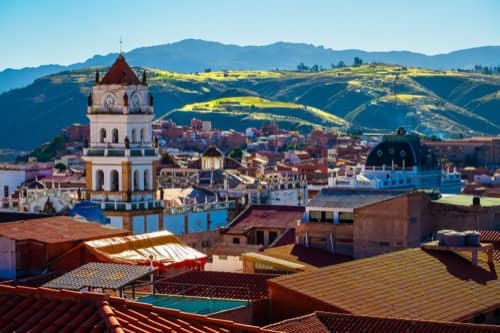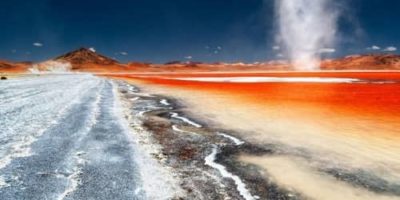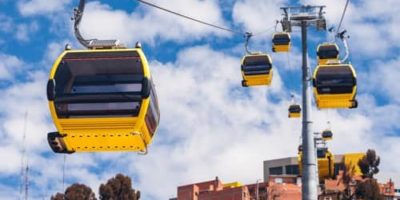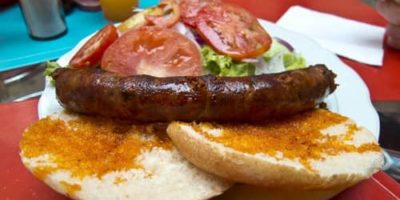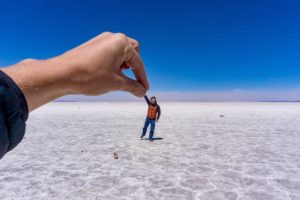Sucre is not just another colonial city in Bolivia. With hundreds of things to do in Sucre, it is Bolivia’s constitutional capital and it is a vibrant, cosmopolitan city. Sucre, which is perhaps the most beautiful city in the country, was declared a World Heritage Site in 1991.
The best things to see and do in Sucre are:
- Plaza 25 de Mayo
- La Recoleta
- Cretaceous Park (Dinosaur Footprints)
- Museo del Tesoro
- General Cemetery
If you don’t have a lot of time in Sucre, the places I mentioned above are the most interesting and definitely worth a visit. If you have a few days to spend in Sucre, here’s the complete list of activities in Sucre.
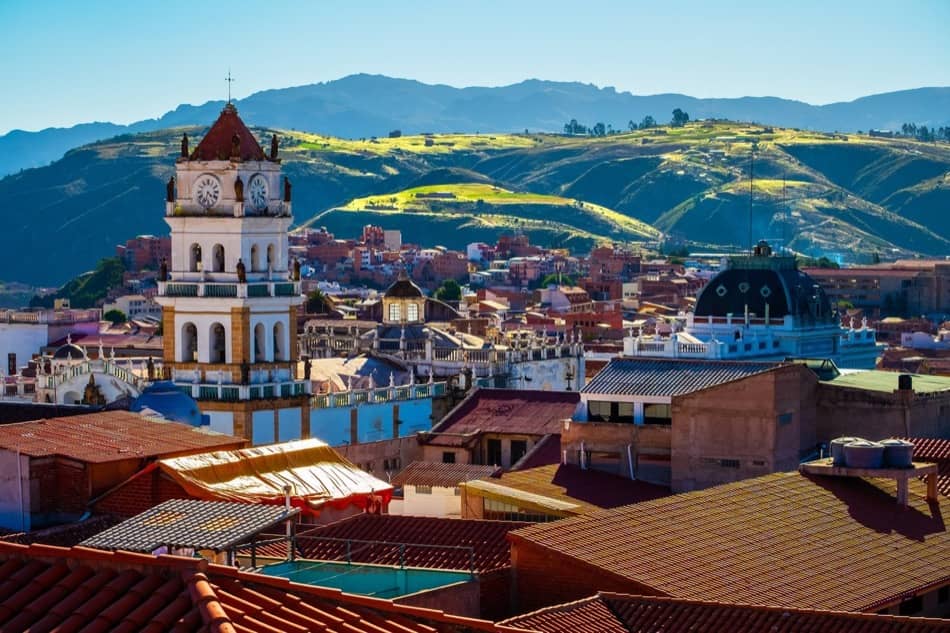
Contents
Plaza 25 de Mayo
If there is one place in all of Sucre where you can feel the pulse of the city, it is right here in the Plaza 25 de Mayo and the colonial streets that start here. The buildings that surround it leave evidence of its past with its great Cathedral and the House of Liberty, where independence was signed.
The best thing about this plaza -and the city in general, for that matter- is that despite being very crowded by locals and foreigners, it maintains a sense of peace and tranquility that makes it the ideal place to have a midday picnic or sit and watch the swaying of its citizens.
But leaving the limits of the square, a walk through its surrounding streets shows in its architecture, the history of the city; and will help you understand why it is called “the white city”: all the colonial houses are white, infusing a calm and peaceful atmosphere to the city.
Here are the best places to eat in Sucre.
Check out the prices for hotels in Sucre here.
La Recoleta
La Recoleta is a viewpoint that’s a little far from the center, on top of a small hill. This viewpoint over the city is especially crowded at sunset. If it is sunny, you can enjoy the sunset while having a coffee from the Mirador café.
It’s a little bit of a climb to get there. The climb will make you sweat, but once you are up, its central square is presided over by the Franciscan monastery to one side a beautiful gallery on the other side, which is the ideal place to watch the sunset over the city. I recommend going up by cab and on your way back, take an easy and pleasant to walk down to the center.
Cretaceous Park
The Cretaceous Park has the most important dinosaur footprints in the world. Yes! Real dinosaur footprints from thousands of years ago, perfectly preserved. It contains more than 5,000 footprints of different dinosaur species. This park was discovered near a cement factory in the city of Sucre. Today, you can visit this park and learn everything about the dinosaurs, their history and why the footprints are still intact.
The park is beautiful. First, they show you a documentary about dinosaurs, and then take you on a guided tour. To protect the integrity of the footprints, you can’t get close to them without a guide but you can see them from a viewpoint with a coin operated telescope.
From Sucre’s main square 25 de Mayo, you can take the tourist bus that takes you to the park. It’ll take you around half an hour to get there. The price for tourists is 45 BOB but for nationals is 15 BOB and for children 10 BOB.
Museo del Tesoro
The Museo del Tesoro is a museum that specializes in the precious metals and minerals of Bolivia. They have a lot of information about the history, geology, and gemology of Bolivian gems. If you are interested in jewelry, you can learn about the entire process; how it is extracted, how it is molded and how the final product is made.
I recommend taking the tour. The tour is well structured and not tiring at all. The tours are available in 3 languages, the guides are very well trained, and the entrance fee is 25 bolivianos. It’s totally worth it.
At the end of the tour, you stop by a souvenir store in the museum. Unlike other museum stores, this one is not a rip off. It is in fact, a very good store with a great variety of minerals you can buy and reasonable prices.
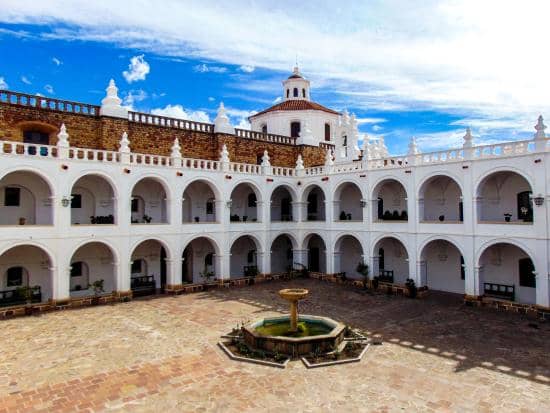
Church of San Felipe Neri
One of the most beautiful places to see in Sucre is San Felipe Neri. This is one of the oldest basilicas in the city, although the most interesting thing is not the church, but the cloister and its terraces – the views from above are breathtaking!
Although it opens only in the afternoon, San Felipe Neri is worth it, especially for the magnificent view of the whole city of Sucre and it’s baroque style chapel. You can walk through the halls and admire the whole structure, the details, some of the paintings, but the magic of the place is in the ceilings. It is the perfect place to go to relax, reflect and read a book or have a moment alone or with a partner.
To enter you must go through the María Auxiliadora School and there the nuns will charge you for the entrance fee. It only opens when there is no class (in the afternoon).
Casa de la Libertad
One of the buildings located in the Plaza 25 de Mayo is the Casa de la Libertad. This is a museum where you can learn about the history of Bolivia in great detail. This is where the constitution of Bolivia as a nation was signed on August 6, 1825, and you can even see the the original manuscript.
To enter the Casa de la Libertad is not to enter another building, but to enter the history of the country from pre-Columbian times to the present day. That great hall is very beautiful, and during your visit, you will also see many historical objects. You will also have a chance to learn the history Juana Azurduy, one of the most famous warriors in the fights for independence. Juana Azurduy was honored postumously by Argentina and Bolivia with the highest military decoration.
The visiting hours of the Casa de la Libertad are from 9 to 12 and from 14:30 to 18:30. It’s closed on Monday. The entrance fee is 15 bolivianos (2 euros) for foreigners and 10 for nationals. Guided tours in several languages are available.
General Cemetery
The General Cemetery is a cemetery with a lot of history of opulence from other times, a cemetery that tells you about princes, barons and duchesses that rest peacefully in a place that combines beautiful mausoleums and living nature.
The cemetery of Sucre, one of the best designed and cared for, keeps in its interior much of the history of Bolivia. Heroes, martyrs and others are the inhabitants of this holy field. Its beautiful gardens give it a special touch that, when accompanied by silence, make it a place of meditation and relaxation.
The General Cemetery of Sucre is 9 blocks from the 25 de Mayo square, so you can walk there or take a bus. Hours: every day from 8am to 11am and from 2pm to 5pm (only 9 streets from Plaza 25 de Mayo)

Museo de Arte Indígena ASUR
The Museo de Arte Indígena ASUR is a great place to see and learn about the textiles of different cultures in Bolivia, that tell you about the past of the people, the experiences and customs and ancestral celebrations that pass from generation to generation.
The most interesting thing is to see the women weaving using their traditional indigenous methods right in front of you. In my opinion, the work of the foundation is wonderful. They help spread information about the valuable cultural heritage of different indigenous people through music, weaving and archaeology.
The women who work in the museum are very friendly and do not skimp on explanations. I recommended stopping by.
Simon Bolivar Park
The Simon Bolivar Park is a very well cared for green area where you can take a break. It is flanked by two impressive buildings. One is the Supreme Court of Justice of Bolivia and the other is the Grand Marshal Theater, which currently belongs to the University. It’s the ideal place to see local families in action and to play paparazzi. You can spend hours watching the families come and go.
Beyond being an oasis in the middle of the city, it is a charming place for sports and people watching. It also has a replica of the Eiffel Tower and a dancing water fountain, among other attractions. Century old trees provide shade and picturesque places like a mini lake and ice-cream parlors in wrought iron huts trap you in the history of this heritage city.
Although it’s just a park, it has so much history that you can get guided tours just for the park. For me, it is the most beautiful part of the historical center of the city. The streets around are picturesque and the park is quiet.
MUSEF – Ethnographic and Folklore Museum
MUSEF (Museum of Ethnography and Folklore) has a resounding collection of masks exhibited in an interesting way. Through masks, the museum displays the variety and history of the country’s carnivals. They also have a room where they project 15-minute videos on cultural, environmental and historical aspects of Bolivia. In addition, it has a sample on the Chipaya culture that is very good.
The museum is located in the heart of Sucre, half a block from the Plaza 25 de Mayo, on the Calle de los bancos. Admission is totally free. It will not take more than 30 minutes to see the entire museum that comprises of 3 rooms.
San Francisco Church
The whitewashed arches of the church of San Francisco are one of the most representative images of the city. It has a very colonial architecture and is one of the most visited landmarks in Sucre.
This church is one of the little jewels of the UNESCO protected historic center. It is very well preserved, white like all the historical buildings of Sucre, and has a lot of history. It was the site of the “Grito Libertario” (Libertarian Cry) of May 25, 1809, considered the first Latin American revolutionary expression of the 19th century.
Inside, you have to pay special attention to the roof which is really impressive because of the spiked frame and its colors. It has a small collection of antique paintings of saints and martyrs, and some altarpieces and pulpits gilded in wood.
Sucre Cathedral
Located in one of the corners of the beautiful 25 de Mayo square, the Sucre Cathedral is a mixture of Renaissance and Baroque styles. Unlike the San Francisco Church, it is more beautiful outside than inside.
Entry to the Sucre Cathedral is totally free. The opening times however aren’t really reliable. It’s best go during mass so you can enter the church and look at the interior.
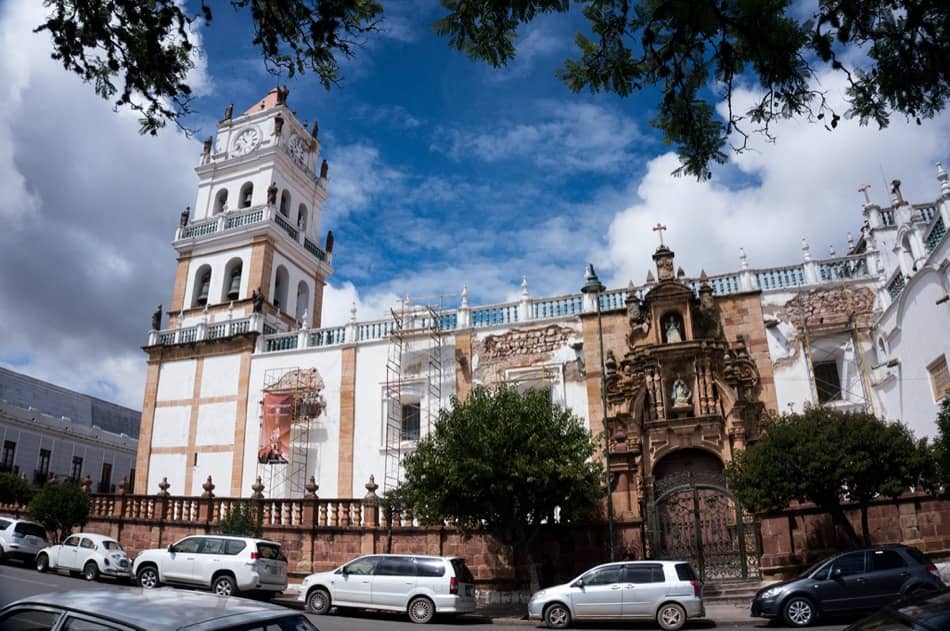
Museo de la Recoleta
The Museo de la Recoleta is part of the Fransiscan convent and is truly a place you should not miss. The museum has important oil paintings, some of them very famous, and even though no photos are allowed, seeing them is a delight. It is a wonderful place that emanates peace and tranquility.
In its cloisters there is a seminary for the aspirants to the Catholic priesthood. Its three colonial patios, the centennial tree, the church’s carved wooden choir, the convent itself and even the surroundings in the square where it is located make it a beautiful place worth visiting.
Located right next to the Recoleta viewpoint, the place is still inhabited. They also have the oldest tree in Bolivia!
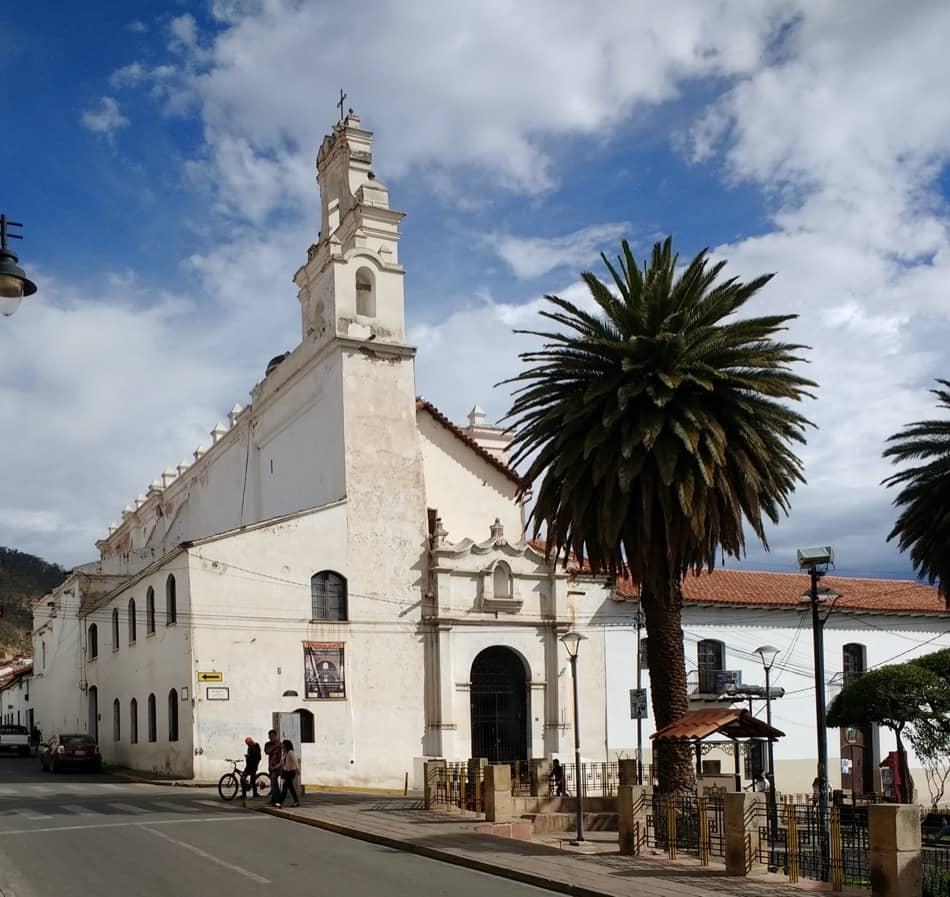
Iglesia Nuestra Señora de La Merced
If you’ve already been to the Recoleta viewpoint, the view from the roof of the Iglesia Nuestra Señora de La Merced is the second best view of the city. A beautiful example of Spanish colonial architecture, the church is worth a visit for its rich interior decoration, beautiful altar and unique pulpit.
The Iglesia Nuestra Señora de La Merced is located two blocks west of the main plaza, just on the opposite corner from the Church of San Felipe. It is open to the public Monday through Saturday from 2:00 to 5:30 p.m. The visit costs ten Bolivianos for tourists and eight Bolivianos for residents.
If you’re lucky enough to arrive late in the evening, you are likely to be rewarded with one of the most beautiful sunsets of your life.
Santa Clara Convent
The Santa Clara Convent is a piece of architectural heritage that keeps the living history of the Colonial era in Sucre. Its museum houses beautiful treasures of invaluable history of what was once the Royal Court of La Plata.
Besides a museum where some pieces of great historical value are exhibited such as paintings and carvings, the main attraction of the museum are the frescoes on its walls. These are paintings dating from the 17th century, made by the cloistered nuns. They are magnificent works located in a very beautiful building.
A top insider tip: You can buy sweets and salteñas prepared by the nuns through a side door to the cloister.
El Centro Turístico Comunitario
The El Centro Turístico Comunitario is the local handicraft center in Sucre where the Bolivians demonstrate how they make their typical handicrafts. It’s a great place to buy gifts and souvenirs since the prices are good and it’s nice to contribute to the local community.
The center also has an Indigenous museum that tells the whole history of the Bolivian people, as well as explains all aspects of the indigenous culture and art embodied in Bolivian society. There are also some songs for you to listen to and some videos to better understand the festivities. The collection is very well taken care of, and has clear explanations.
The tapestry and weavings are spectacular and the customs and history of the culture of the indigenous people of Bolivia is wonderful. Be sure to make it a part of your visit.
University of Saint Francis Xavier
The University of Saint Francis Xavier is one of the oldest and most important universities in Latin America. It should be visited because its main campus is a jewel of colonial architecture, and this university has great importance for the history of Bolivia and Argentina.
The University was founded by the Jesuits in 1624 and is one of the oldest in the Americas. The beautiful and spacious colonial cloister is freely accessible from Junin Street, very close to the Plaza. It has an incredible library with volumes dating back to 1600s and the original furniture is spectacular.
The different faculties are dispersed throughout the city, but this building is where the Paraninfo Universitario (concert hall), the administrative offices and part of the Law School are located. This building is located one block from the 25 de Mayo square.
Museo San Francisco de Asis
Museo San Francisco de Asis is a place that is necessary to visit in order to understand the history of Bolivia and, especially, of Sucre. There were two things that caught my attention the first time I was there. The majestic altar and the sculptural interpretation of God.
The ornamentation and decoration is very antique and shiny and you can visit the crypt where the remains of the most notable Spaniards are located. The upper terrace houses the famous bell that prompted the first South American cry for freedom in 1809.
Although entry is free, guided tours are available in case you’re interested.
The 7 Waterfalls
If you feel like going on a mini hike and then swimming under some waterfalls, then you’re going to love the 7 Waterfalls. The first few waterfalls are very easy to get to. It gets harder and more strenuous from the fourth one onward. It’s a delightful adventure.
Arrive in the morning to make the most of the place and have a picnic in a magical setting. The seven waterfalls is an excellent place for a day in the countryside. It’s easy to get to since you can walk there in an hour or so, take a public bus, rent a bike or take an organized tour.
Make sure you take your bathing suit and a good pair of shoes.
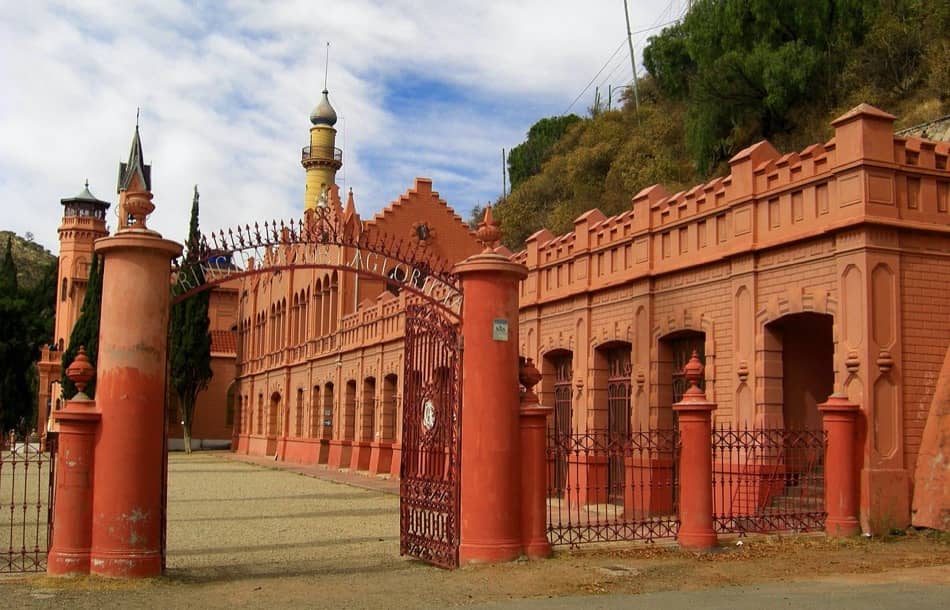
La Glorieta Castle
The La Glorieta Castle is very beautiful, although it is a little neglected. The place has tour guides who explain details of the construction of the castle and the family history of the castle owners.
The photos show that it had beautiful gardens which do not exist today. The castle itself is very neglected and it is regrettable that no restoration work is being done. That said, it’s a great place to visit even though it’s far from the city.
